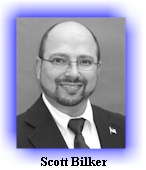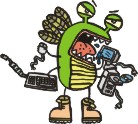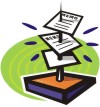9 Steps to Get Organized for Financial Success!
by
Scott Bilker |
|

The
beginning of my financial life was when I received my driver's license.
Before that I rode my bicycle around and had no bills. Well, I
needed a car, right? I had to get to work so I could pay for the
car, to get to work.
That's what started the bill cycle. The car
was used (pre-owned), so I had no payments, but I was using my gas credit card
to get around. And let's not forget that I could now go
to the mall, buy stuff, and take Larissa on dates better than McDonalds (we started dating before I could drive). So it
didn't take long for the bills to start arriving in the mail.
I just didn't know what to do with
this mail. Nobody ever showed me a system for managing bills because
I didn't have any to keep organized.
So what did I do back then? Probably
what many people do today. Bring in the mail, stack it on a desk,
and tend to the pile at the last minute. Hopefully, I didn't miss too
much because I frequently found mail on the floor behind the desk.
It didn't take long for me to realize
that I had to do something. I had to get organized!

That was a lifetime ago, really, I
was 18 (1984) then, now I'm insanely organized about handling money,
bills, and all finances. I've learned over the years that the better
organized you are with all your transactions, the less likely you are
to:
 |
Bounce checks. |
 |
Exceed
credit limits. |
 |
Pay late. |
 |
Get charged for stuff you didn't buy. |
 |
Get hooked into extra charges. |
 |
Be stressed over bills. |
 |
Go into perpetual debt. |
 |
Let
fraud go unnoticed. |
Here are the 9 quick steps to getting
organized for financial success--today!
1) Filing system.
When it comes to getting organized, everything needs a place, a home,
a spot. The basic filing cabinet is the best way to organize the
paperwork.
The hanging files are the best. They're just easier to
work with, easier to access. A basic filing cabinet costs around $30
and is well worth the price.
Once you have a filing cabinet, and
some hanging files, create a file for each bill and bank account,
for example, mortgage/rent, electric, cable TV, water/sewer, health
clubs, checking account, savings account, cash receipts, etc. For
credit cards, I name the file by the bank name and the last four
digits of the card number, i.e., "Citibank 4323."
Lastly, create one more file called,
"Bills Unpaid." This is the place to put all those annoying
statements until you have time to write the checks.
2) Take care of the mail when it
arrives.
Don't let the mail pile up! As soon as you bring in the daily stack
of bills, which is what most of it is anyway, go through each
envelope immediately. What I do is open every bill, throw away all
the frivolous inserts, staple the statement to the
bill-payment envelope, then place it in the Bills Unpaid
file

Now, when you're ready to sit down and
take care of the payments, all your bills will be in place. You won't
have to spend time going through each envelope before writing the
check.
3) Use accounting software.
I know everyone reading this article right now has a computer. That
means you should be using software to track your spending and
organize your financial life. I cannot think of a better use of
the computer for people in general!
"If you have a computer, then you
should be using financial software." That's a quote.
Why?
Money is like the blood of your
financial life. It flows into every aspect of what you do. It
circulates in, out, and all around everyone in the family. By using
your computer to track spending, you'll always know exactly what's
going on, where money is being spent, and how to plan for new
purchases.
The most powerful aspect about using
software is eliminating that checking ledger. I haven't written in a
check ledger since 1987! I have searchable records of every credit
card charge and check that I've written in my entire life!
The best part is that I don't bounce
checks. It's easy to balance your checking account using the
computer. There's no adding, subtracting, etc. You just match the
checks (and ATM withdrawals) with your bank statement, and everything should
balance. If it doesn't, then you can quickly find the problem.
You know how you sometimes get a bill
that you think you've already paid? It's very easy confirm by
doing a search with the computer.
A word of caution: if you do use
software, then you MUST back up that data! It won't take long for you
to completely abandon those paper ledgers, but PLEASE make a back up
EVERY time you work on your bills!
Keep in mind that tracking alone
won't solve money problems. For example, in 1995, I created a report
for the year that detailed all my spending by category. I spent 18%
of my income on the mortgage, 11% on groceries, 9% for utilities, 6%
on
federal tax, 6% on social security tax, 6% on property tax, 5% on
medical.
Those are the top-spending categories,
which used more than 50% of my income for the year. I cannot make
changes in any of those categories unless I decide to sell my
house, or cut back on dental fillings. Tracking lets me know where the money is
going, but I have limited control over those categories. Areas I
can change don't really add up to much, like 1.4% for entertainment.
4) Enter the transactions into the
computer.
 The software will not be helpful unless you enter the transactions.
A strategy for accomplishing this is to put all credit card
receipts in the Bills Unpaid file as soon as you get home from
shopping. Then you
can enter these transactions into the computer on the same day you
pay bills.
The software will not be helpful unless you enter the transactions.
A strategy for accomplishing this is to put all credit card
receipts in the Bills Unpaid file as soon as you get home from
shopping. Then you
can enter these transactions into the computer on the same day you
pay bills.
Entering your transactions in the
computer is the confirmation that your perception of what's going on
matches your bank's. That means that the information on your computer should
be accurate, and the credit card statement better match what your
computer says or there's a mistake somewhere. It's your way to make
sure you really did charge every item and write every check. It's
the way to detect fraud and bank mistakes!
5) Pay bills on a specific day.
The one lesson I learned early on is that I didn't want to be tortured
by dealing with bills every single day. That's why I put
the bills in the Bills Unpaid file, and that's why I choose to pay
bills once every two weeks--on pay day, always a good time, when I
had the money. :)
It usually takes me about 2 to 3
hours to pay my personal bills once every two weeks. Once I start on
this task, I'm focused! I review every single credit card statement,
check, transaction, credit offer, etc. to make sure that I'm receiving the best rates and lowest cost credit options.
Each transaction is carefully
recorded in the computer. It's important that on this "bill pay
day" everything matches. My billing statement matches what I have
in the computer and all accounts balance. All check numbers line up
so there are no missing checks.
6) Balance your checking account.
I've already mentioned this point, however I cannot stress it
enough. Many people do not balance accounts, and it's very costly if
you don't. The consequence: bouncing checks. The fees for
this can be as high as $35 from your bank and $35 from the bank of
the person who you wrote the check to.
By balancing your accounts and using
software to handle transactions, you can easily avoid an incident
similar to one
that happened to a friend of mine. She accidentally wrote two checks
for her mortgage, and the mortgage company cashed both. The result
was that ALL her other checks bounced like super balls! The cost,
when the smoke cleared, for those bounced checks was more than $800
plus the aggravation of dealing with all the banks, freezing of
accounts, and stress.
7) Create a list of all bills and
debts.
One sheet of paper listing all bills, debts, due dates, contact
phone numbers, etc. is one of most powerful tools for financial success!
I've included many of these worksheets in my best-selling book, Credit
Card and Debt Management.
Each time you pay bills, be sure to
update the list. I started out with a list on paper, then I moved to
using Excel. Now, because I have so many credit cards, I had to
create an Access database to track that information.
You need this list to be your
roadmap. It's a planning tool for future spending. You'll be able to
see your spending plans at a glance.
8) Create a list of credit offers.
 You know that "junk mail" from your credit cards? Well some of those
low rate offers are actually VERY good! I always keep a list of
current offers from all of my active credit card accounts. Usually, half of my
credit card banks are offering me transfer deals with rates less than 5.99%! Some
are even a true 0%!
You know that "junk mail" from your credit cards? Well some of those
low rate offers are actually VERY good! I always keep a list of
current offers from all of my active credit card accounts. Usually, half of my
credit card banks are offering me transfer deals with rates less than 5.99%! Some
are even a true 0%!
I also keep a list of new credit card
offers; however, I do prefer to take advantage of the offers from my
current banks since I have a long history of doing business with
them, giving me more bargaining power.
The key here is to create these
lists. This way, if one of your current credit card banks raises their
rate, you don't have to look very far to find a better deal. You
don't have to keep a stack of mail to go through. You simply pull
out the list and start calling!
9) Start a financial notebook.
I keep all my notes on the computer, but there was a time when I
actually wrote in a book, how barbaric is that! :)
Whether by hand or in a computer, this
is very important! You need to have detailed notes when you contact
your credit card banks, checking bank, mortgage company, etc.
The reason is that sometimes the
phone reps don't make the proper notes in your account, and you'll
need to reference your notes to keep all those banks in line.
Your financial notebook should
include your strategies, for example, "Be sure to transfer the
$2,000 balance from the Discover card to the Advanta 3.9% offer by
11/25." The beauty of keeping an organized notebook is that you
can refer to your notes, which means you don't have to think about
all the details all the time.
So there you have it. I have followed
these steps for financial organization for years with incredible
results. I've kept my interest costs down, I only have to deal with
bills and payment one day every two weeks, I rarely bounce checks, I
have corrected many bank errors, and I
don't have to think about financial details on a moment-to-moment
basis.
--End--
| 